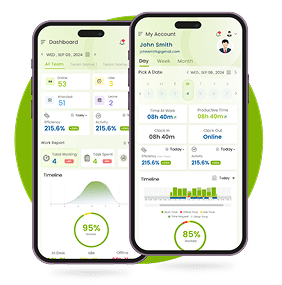Did you know that 70% of employees admit to wasting time at work, costing businesses billions each year? Managing time effectively is one of the biggest challenges teams face today, especially with remote and hybrid work on the rise. Are your teams struggling with missed deadlines, burnout, or unclear work priorities? If so, you’re not alone.
The good news? Free online time trackers are helping thousands of teams regain control by simplifying how they track work, increase productivity, and improve transparency, all without breaking the bank.
In this blog, you’ll find why adopting a free online time tracker like Desklog is no longer optional but essential for modern teams aiming to maximize efficiency in 2025.
Overview:
Why Do Teams Choose A Free Online Time Tracker?
Teams choose a free online time tracker to increase rate of efficiency, reduce manual time logging, track productivity, and improve project planning without investing in costly software. These tools offer real-time tracking, better team transparency, and effortless reporting, ideal for remote or hybrid teams.
The Hidden Cost of Poor Time Management
Poor time management is more than just a frustrating inconvenience; it has real business consequences.
Missed Deadlines and Employee Burnout
When teams don’t have a clear picture of how time is spent, projects tend to run over schedule. Tasks overlap, priorities shift without notice, and employees often work longer hours trying to catch up. This creates employee burnout, disengagement, and a rise in turnover. For HR professionals and managers, this cycle is expensive and demoralizing. Recruitment, onboarding, and training costs soar as experienced talent leaves due to chronic stress and lack of recognition.
Overlapping Tasks and Manual Reporting Headaches
In many organizations, time tracking is still manual; employees log hours in spreadsheets or email their timesheets at month-end. This approach is error-prone and tedious. Duplicate entries, forgotten hours, or inflated reports lead to inaccurate payroll and billing, frustrating finance teams and clients alike. Managers end up spending hours chasing updates instead of focusing on strategy, reducing their overall effectiveness.
Poor Resource Allocation and Lost Opportunities
Without accurate insights into time usage, managers can’t identify which tasks drain productivity or which projects deserve more resources. This results in overstaffing low-value work while critical projects suffer delays. Opportunities for new clients or innovation are often missed simply because the team is bogged down in the wrong priorities.
Communication Breakdowns and Workflow Bottlenecks
Time mismanagement often triggers miscommunication; updates are missed, deadlines are unclear, and responsibilities overlap. This leads to workflow bottlenecks, where one delayed task stalls an entire project. The resulting downtime is not just unproductive, it’s costly, both in terms of lost billable hours and client trust.
Declining Employee Morale and Trust Issues
When workloads are poorly balanced and expectations are unclear, resentment builds. High performers feel punished for being efficient, while others become complacent, assuming someone else will pick up the slack. Over time, this erodes trust in leadership and reduces overall team morale, creating a culture resistant to collaboration.
Why Traditional Time Tracking Methods Fail In 2025?
The modern workforce is increasingly remote, hybrid, and project-driven. Traditional methods like paper timesheets, punch clocks, or simple spreadsheet trackers simply can’t keep pace. They lack transparency, automation, and scalability.
As companies grow or embrace flexible work, these manual processes become bottlenecks that slow down operations and obscure true productivity data.
What is a Free Online Time Tracker?
To understand why teams are flocking to these tools, it helps to define what a free online time tracker really is.
Definition
A free online time tracker is a cloud-based or browser-accessible software tool that enables individuals and teams to accurately track work hours, measure productivity, and manage tasks in real time. It records time spent on projects, applications, and websites automatically or manually, offering detailed reports for improved workflow efficiency, payroll accuracy, and project management; without any upfront cost.
Core Functions
Most free online time trackers offer essential features that bring time management and improve accuracy, such as:
- Automatic time capture – Instantly logs when a task or project starts and stops.
- Idle time detection – Pauses tracking during inactivity to prevent inflated work hours.
- Activity monitoring – Tracks apps, websites, and documents to analyze productivity patterns.
- Timesheet generation & reporting – Creates detailed, exportable records for payroll, billing, or project analysis.
- Offline time tracking – Records work even without internet access and syncs data automatically when reconnected.
By automating these processes, time trackers minimize manual entries, reduce errors, and deliver highly accurate work data.
Who Should Use a Free Online Time Tracker?
Free online time trackers cater to a wide spectrum of professionals and teams, offering flexibility across work environments.
Here’s how different users can benefit from them:
| User Type | Key Benefits |
|---|---|
| Freelancers & Consultants | Accurately track billable hours, simplify invoicing, and maintain transparent client reporting. |
| Remote Teams | Provide real-time visibility, ensure employee accountability regardless of location, and track productivity. |
| Hybrid Teams | Monitor work both in-office and remotely, ensuring consistent performance measurement. |
| In-Office Teams | Automate attendance and work logs, eliminating manual paperwork and reducing administrative time. |
| All Users | Identify productivity trends, track project timelines, and ensure every billable hour is recorded. |
Paid vs. Free Online Time Trackers: What’s the Difference?
Paid time tracking software typically offers advanced features like in-depth analytics, payroll and invoicing integrations, API access, and priority support. Free versions, however, have evolved to cover all core essentials; including automated tracking, timesheet generation, and idle time detection, often without usage limits or hidden costs. This makes them an excellent starting point for startups, small businesses, and teams wanting to validate a tool’s efficiency before investing in a premium plan.
What are the Benefits of Online Time Trackers?
Too much productive time slips away when teams are left to manually track their hours; starting timers, remembering punch-ins, jotting down shift changes, or logging work at the end of a long day. These gaps are more than minor inconveniences; they add up to lost visibility over team and employee performance. Missed clock-ins, forgotten break logs, and scattered project updates create an incomplete picture of actual productivity, making it harder for managers to make informed decisions.
Desklog’s Automated Time Tracking eliminates the guesswork by starting the clock as soon as an employee logs in. It automatically captures Clock In & Clock Out times without requiring a single manual step, recording every active minute in real time. This continuous tracking not only ensures accurate payroll and project billing but also gives managers a transparent, day-by-day record of how work unfolds, without burdening employees with administrative chores.
Filling out timesheets manually is a task that often gets pushed aside in the rush of daily work. It’s slow, prone to human error, and when neglected, can lead to payroll delays, incorrect invoices, and frustration for both staff and clients. Relying on manual entries also means accuracy is dependent on memory, which is far from reliable after a week of tasks and deadlines.
Desklog’s Automated Timesheet removes these inefficiencies entirely. The system compiles tracked work hours into ready-to-use daily, weekly, or monthly records without the need for user input. Teams no longer have to hunt for missing entries, and managers can instantly review complete, up-to-date work logs. Whether it’s for payroll processing or client billing, the data is already organized, precise, and ready to go, saving valuable time on both ends.
Some roles involve jumping between multiple small tasks; replying to client emails, fixing quick issues, or switching between different tools. Manually tracking each micro-activity can be disruptive, and in most cases, those minutes go unrecorded. Over time, these unnoticed gaps quietly accumulate into significant blocks of unbilled or unaccounted work.
Desklog’s Web Timer offers a fast, frictionless way to log these moments. Directly accessible from the browser, it lets users start and stop timers instantly, without leaving the tool they’re already working in. This means small, rapid-fire tasks get accurately tracked, ensuring a truer reflection of where time is going and improving the reliability of client billing or performance measurement.
Idle time is an invisible productivity drain. It can slip into the workday unnoticed, waiting for systems to load, taking a personal call, or getting pulled into a non-work discussion. If left unmonitored, these moments get counted as work hours, skewing productivity metrics and making performance reports less trustworthy.
With Desklog’s Idle Time Tracker, inactivity is automatically detected and categorized separately from active work. Managers and employees can see exactly how much time was spent actively producing work versus idle. This transparency not only gives a more accurate picture of actual productivity but also helps identify patterns that can be addressed to optimize focus and output.
For remote teams, especially those in regions with inconsistent internet connectivity, network disruptions can be more than just frustrating, they can mean losing hours of tracked work. A temporary outage can leave gaps in timesheets, causing disputes over worked hours and impacting billing accuracy.
Desklog’s Offline Time Tracking solves this by storing activity data locally whenever the internet drops. Once the connection is restored, all the stored records are automatically synced to the system, ensuring no information is lost. This creates uninterrupted tracking coverage, regardless of network stability, and builds trust between managers and remote employees.
When you can’t see how much time is being spent on each task, projects often overrun budgets and schedules. Manual tracking makes it difficult to link hours worked to specific deliverables, leading to inefficiencies and poor workload distribution.
Desklog’s Project Time Tracking logs every minute spent on each project or task, creating a clear, itemized record of effort. Managers gain insight into where time is being invested, which tasks are causing bottlenecks, and whether workloads are balanced across the team. This level of clarity improves budgeting, enhances client reporting, and enables better resource allocation for future projects.
Working for long stretches without breaks can lead to fatigue, reduced focus, and more frequent mistakes not to mention long-term health impacts. Yet on a busy workday, it’s easy to skip breaks, often without realizing it.
Desklog’s Wellness Module is designed to help teams maintain sustainable work habits. It encourages regular, structured breaks, tracks inactivity that could signal fatigue, and nudges employees to step away before productivity drops. This promotes better mental and physical well-being, brings work-life balance, reduces burnout, and helps employees return to their tasks with renewed focus benefiting both the individual and the organization.
Integration with Existing Tools
Free online time trackers like Desklog aren’t just for logging hours, they’re built to work easily with the tools you already rely on. By integrating with project management, communication, and payroll platforms, they create a connected ecosystem where data flows automatically, reducing repetitive work and ensuring accuracy at every step.
1Project Management Sync
Integrate directly with tools like Trello, Asana, or Jira so tracked hours are automatically assigned to the right tasks and projects. This ensures real-time visibility into progress, eliminates the need for manual updates, and helps managers track resource allocation more effectively.
2Communication Tool Integration
Connect with platforms like Slack or Microsoft Teams so employees can clock in/out, submit time logs, and receive updates without switching apps. This keeps workflows uninterrupted while improving team responsiveness and collaboration.
3Payroll Automation
Link time tracking with payroll systems to automatically pull approved work hours into salary calculations. This not only prevents human errors but also speeds up payment processing, ensuring employees are paid accurately and on time.
4Centralized Workflow
Bring time, task, and payroll data into one unified platform. This centralization reduces duplicate entries, eliminates inconsistencies, and makes reporting faster and more reliable.
5Less Admin, More Productivity
By removing the need for manual data transfer between systems, teams can focus more on delivering work instead of managing tools. This efficiency translates into smoother operations and better project outcomes.
Security and Privacy in Free Time Tracking Tools
Your time-tracking data isn’t just numbers, it’s valuable information that deserves strong protection. Reliable free time tracking tools safeguard this data through secure storage, encryption, and strict access controls to keep your work history private.
Data Storage Practices
- Time-tracking data is stored on secure servers with regular backups.
- Cloud storage is hosted on reputable providers with strong physical and digital security.
- Regular vulnerability scans ensure no weak points in storage systems.
Data Encryption
- In-transit encryption: All data transferred between your device and the server is protected with SSL/TLS protocols.
- At-rest encryption: Data is encrypted even when stored, preventing unauthorized access in case of breaches.
- Encryption keys are managed with strict security policies.
Access Control & Permissions
- Role-based access ensures only authorized personnel can view or modify time logs.
- Two-factor authentication (2FA) adds an extra layer of security.
- Activity logs track all access attempts to detect suspicious behavior.
Compliance with Privacy Regulations
- Adheres to major data protection laws like GDPR, CCPA, or regional equivalents.
- Offers transparent privacy policies on data collection and usage.
- Users can request data export or deletion at any time.
Regular Security Audits
- Independent security audits identify and fix potential vulnerabilities.
- Continuous monitoring for unauthorized access or unusual activity.
- Frequent software updates to patch known security flaws.
Why Free Doesn’t Mean “Limited” in 2025
Once upon a time, “free” software meant you got a tiny slice of the real thing, just enough to tempt you into paying. The free version was a placeholder, a preview, and often so restricted it was barely usable. But 2025 has rewritten that story.
The market is now flooded with tools that understand something critical: value builds loyalty, and loyalty brings growth. Instead of holding features hostage behind paywalls, companies are offering genuinely useful free plans, feature-rich enough for individuals, freelancers, and even small teams to run their operations effectively.
Three key shifts make this possible:
- Freemium as a Growth Engine – Businesses have realized that providing real functionality upfront builds trust faster than hard-selling.
- Competitive Saturation – With so many alternatives available, free tiers need to stand out to attract adoption.
- Community-Driven Models – Some products rely on network effects or community contributions, where value comes from more people using the tool.
Take time tracking, for example. A “free” plan today might include automated tracking,
project
allocation, offline mode, and wellness features,
things that were once premium extras. The aim isn’t to shortchange you, but to let you
genuinely
experience the tool’s core value without barriers.
In 2025, free doesn’t mean limited, it means confident. Confident that if you love the
product at no
cost, you’ll be more than willing to grow with it when your needs expand.
Conclusion
Adopting a free online time tracker is no longer just a convenience, it’s a strategic advantage. Tools like Desklog.io empower teams to reclaim lost hours, improve transparency, automate tedious tasks, and boost productivity all without upfront costs or complex implementations.
For HR professionals, managers, and operations heads seeking efficient, scalable solutions in 2025, Desklog’s free plan offers unmatched value and functionality. If you want to reduce manual errors, increase team trust, and gain real-time visibility into your projects, it’s time to explore what a free online time tracker can do for your team.
Your Search For The Ultimate Employee Efficiency Tracker Ends Here.
FAQ
1 Are free online time trackers accurate?
Yes, modern time tracking tools are highly accurate thanks to real-time tracking, automated activity logging, and idle time detection. They record tasks down to the second, eliminating the need for manual input. Many tools also sync across devices, so you don’t lose data when switching workstations. This ensures you always have a precise record of your working hours.
2 Can I use a free time tracker for a large team?
Absolutely. Many free tools, including Desklog, support unlimited users or offer scalable free tiers suitable for large teams. Features like centralized dashboards, role-based access, and project-wise tracking make it easy to manage workloads. Even for big teams, these tools ensure transparent reporting and better coordination without extra cost.
3 What’s the difference between time tracking and productivity tracking?
Time tracking simply logs how long you’ve worked, while productivity tracking goes deeper to analyze how that time is spent. For example, productivity tracking shows which apps, websites, or projects take up most of your day. This insight helps managers and employees identify workplace distractions, simplify workflows, and improve overall efficiency. Both work best when used together.
4 Is Desklog completely free?
Yes, Desklog offers a free plan with all the essential time tracking features you need to get started. This includes automatic tracking, timesheets, project logs, and idle time monitoring. For businesses that want advanced reporting, integrations, and deeper analytics, paid plans are available. This flexible pricing makes it a fit for both startups and enterprises.
5 Does time tracking affect employee privacy?
Ethical tools like Desklog are designed with privacy in mind, offering customizable tracking modes and clear data policies. Managers can adjust monitoring levels to fit company culture while respecting personal space. Employees are informed about what is being tracked, and sensitive data is protected through encryption. This balance ensures accountability without micromanagement.
6 Do free time trackers work offline?
Yes, many free time tracking tools, including Desklog, have offline tracking capabilities. They store work data locally when there’s no internet and automatically sync it once you’re back online. This prevents data loss during network outages and ensures every minute of productivity is recorded. It’s ideal for remote teams or field workers in low-connectivity areas.
7 Can I integrate a free time tracker with other tools?
Most modern trackers support integrations with project management, communication, and payroll software. This means your time logs can automatically update task boards, send alerts to team chats, or feed into invoicing systems. Integrations save time, reduce duplicate work, and create a more centralized workflow for the whole team.
8 How secure is my data on a free time tracker?
Reputable tools use strong encryption, secure servers, and role-based access control to protect user data. Many also comply with global privacy regulations like GDPR or CCPA. Security audits and regular updates ensure vulnerabilities are quickly patched. This way, your work history and project data stay confidential and safe.
















